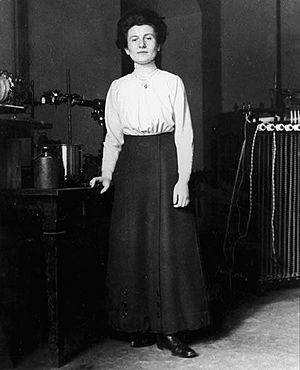Hedwig Kohn facts for kids
Quick facts for kids
Hedwig Kohn
|
|
|---|---|

Kohn in her laboratory, 1912.
|
|
| Born | 5 April 1887 |
| Died | 26 November 1964 (aged 77) |
| Alma mater | Breslau University |
| Scientific career | |
| Fields | Physics |
| Institutions | Breslau University University of North Carolina Wellesley College Duke University |
| Thesis | (1913) |
| Doctoral advisors | Otto Lummer, Rudolf Ladenburg |
Hedwig Kohn (born April 5, 1887 – died November 26, 1964) was an important physicist. She was one of only three women in Germany to become a university professor in physics before World War II. This special qualification was called "habilitation."
Born in Breslau, Germany (which is now Wrocław, Poland), Hedwig Kohn had to leave her home country. This was because of the Nazi government, which was against Jewish people. She moved to the United States and continued her amazing work in science there for the rest of her life.
Contents
Hedwig Kohn's Life Story
Early Years and Education
Hedwig Kohn was born in Breslau, Germany. Her father, Georg Kohn, was a merchant, and her mother, Helene Hancke, came from a well-off family. Both of her parents were German Jews.
In 1907, Hedwig started studying at Breslau University. This was a year before women were officially allowed to enroll there. She became only the second woman to join the physics department. In 1913, she earned her doctorate in physics under the guidance of Otto Lummer. Soon after, she became Lummer's assistant.
During World War I, she stayed at the university's Physics Institute. She taught students and helped those working on their doctorates, even though she was quite young. After the war, she received a medal for her hard work. In 1930, she achieved her "habilitation," which meant she was qualified to teach physics at a university.
Escaping from Germany
In 1933, Hedwig Kohn lost her job because of new Nazi laws. These laws stopped Jewish people from working in government jobs, including at universities. In 1935, with some money from the United States, she spent three months in Switzerland. There, she measured the strength of ultraviolet rays from the sun. However, this did not lead to a permanent job.
She managed to survive by doing research for lighting companies until 1938. By then, she had no work or money and was in great danger. Her only brother was taken to a concentration camp and killed during the Holocaust.
It was very hard for Hedwig to find a job outside Germany. Many Western countries had few university jobs because of the Great Depression. Also, being German, older, and a woman made it even tougher. Sadly, some people were also against Jewish people, which made things worse.
With help from many people, including Rudolf Ladenburg, Lise Meitner, and Hertha Sponer, Hedwig was offered temporary jobs at three women's colleges in the United States. She got a visa for the United Kingdom in 1939, but it was canceled because of World War II. She then got a visa for Sweden and went there in July 1940.
After getting a visa for the United States, she moved there. Her long journey to her first job in Greensboro, North Carolina, took her through many cities. These included Berlin, Stockholm, Leningrad, Moscow, Vladivostok, Yokohama, San Francisco, and Chicago.
Life in the United States
When Hedwig Kohn arrived in the United States in January 1941, she was very sick. After she got better, she taught at the Women's College of the University of North Carolina at Greensboro for about a year and a half.
In 1942, she started teaching at Wellesley College in Massachusetts. She began as a lecturer, became an associate professor in 1945, and then a full professor in 1948. At Wellesley College, Professor Kohn set up a special lab to study light from flames, called flame spectroscopy.
She was also a member of several important science groups in the United States. These included the American Physical Society and the American Association of Physics Teachers.
When Professor Kohn retired from Wellesley College in 1952, Hertha Sponer, a physics professor at Duke University, offered her a research job. Hedwig Kohn set up another lab at Duke University. She continued her research there, helping two students earn their doctorates. She also hired two post-doctoral fellows to help her study flame spectroscopy. She worked at Duke University almost until she passed away in 1964.
Hedwig Kohn's Impact
Hedwig Kohn learned how to precisely measure the brightness of light from her teacher, Otto Lummer. She studied light from wide sources, like a "black body," and from the specific light given off by atoms and molecules. She improved these methods and found ways to learn more from light measurements.
She wrote 270 pages in a major physics textbook used in Germany during the 1930s and 1940s. She also received one patent and wrote many articles for science magazines. Some of her articles were still being used as references even in the 2000s. Professor Kohn also wrote a textbook that helped students learn about measuring light well into the 1960s. Two of her students later became professors in Germany.
On April 5, 2019, Google Doodle honored Hedwig Kohn on what would have been her 132nd birthday.
See also
 In Spanish: Hedwig Kohn para niños
In Spanish: Hedwig Kohn para niños

